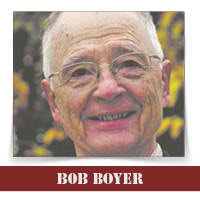
By: Bob Boyer
Last month this column introduced Lieutenant Colonel Joe Rogers, Philippine Air Corps, the son of a Filipino mother and an American father. Joe’s father had been an American soldier who fought in the Philippine –American war (1899-1901) and then fell in love, married and settled in the Philippines. I wrote to celebrate the 2020 Fourth of July holiday by sharing an experience I had in Manila in 1998 that illustrates to me “the signifi cance, and the closeness, of the Philippine-American relationship.” I could have added “complexity.” I met and ended up interviewing Joe Rogers that July 4 in 1998. Here is a slightly edited version of Part Two of that interview
“You were on the Bataan death march?” I interrupted, in a tone of awe, remembering my childhood when a reference to Bataan conjured up images of stoic courage by Philippine and American prisoners and atrocities by their Japanese captors. Joe responded with some further details about the march. He spoke in the manner of a storyteller, in a tone that betrayed no perceptible animosity toward the invaders. “There wasn’t enough food or water. The Japanese didn’t have much either. They didn’t know what to do. Those (prisoners) who couldn’t keep up were shot.”
“When they got us to the camp, Camp O’Donnell (they were later moved to the infamous camp at Cabanatuan), they tried to turn the Filipinos against the Americans. They divided us, putting the Americans on one side of the road and us on the other. I looked so Filipino that they never thought of checking me out any further.” Again Joe smiled broadly, enjoying this irony. He continued. “Gradually the Japanese tried to persuade us to renounce the Americans and even join the Constabulary or the Japanese army. A few did, but not many. They treated us a little better than the Americans, but nobody had enough to eat or drink, so they released the Filipinos after three or four months of internship.”
“Joe continued his narrative, telling of his assistance to the underground and guerrilla movements, but at this point the gathering began moving toward the hall for the dramatic reading. Still Joe and I lingered, and Joe encapsulated some of his subsequent history. “I was a pilot in the fl yover at the Signing of Independence in 1946 (July 4).” He beamed and paused meaningfully but said nothing. And I took his point. The Filipino son of an American soldier who fought against the Philippines in an earlier war, piloted a plane in the fl yover as the US recognized the independence of its Philippine allies after World War II. I could understand why he was attending today’s Fourth of July event.”
“Joe concluded his story as we started toward the hall. He rose to the rank of lieutenant colonel, at which time he was asked to accompany several diplomatic missions to Southeast Asia. I could see that he would be a good military attaché. He was offered the rank of general if he would continue these missions, but he wanted to fl y, “So I turned it down,” said Joe, with a smile that confi rmed that he had made the right choice. We parted, as he joined his group of friends.” Joe joined his group, after I had pretty much monopolized him for the whole time before the entertainment part of the annual Fourth of July meeting of the American Studies Association of the Philippines. As I mentioned in this column last month, my Fourth of July in Manila in 1998 joined my many memories of that holiday, going back to my childhood during World War II, when I hammered on caps to make a bang. In 1998 Joe helped to expand my sense of the signifi cance of July Fourth of July as well as my understanding of Philippine-American relations.
Joe’s father had come to the Philippines with what turned out to be an army of American occupation for nearly half a century. Yet Joe became a pilot in the U.S. Air Corps in 1941, helped the underground against the Japanese, proudly fl ew in the celebration of Philippine independence (from the U.S.) in 1946 (July 4), and joined in the celebration of Philippine-American Friendship Day in 1998 (July 4). Joe Rogers does indeed represent the closeness and the mystery of this international relationship.
I would love to hear what you think, at Robert.boyer@snc.edu.
 VIA Times – August 2020 Issue Vital News, Vibrant VIews for Asian Americans in Chicago & Midwest
VIA Times – August 2020 Issue Vital News, Vibrant VIews for Asian Americans in Chicago & Midwest

